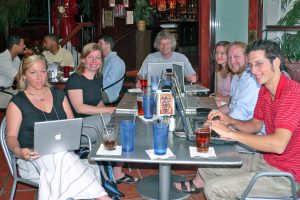My very first thermometer came as a gift from Pete.
I was a newbie graduate student, full of hubris, trying my best to figure out how to communicate food safety to food handlers in restaurants. I started making these food safety infosheets (which have morphed into other things) and Pete was a concerned reader of FSnet (which morphed into barfblog).
After posting something that I likely put together in haste, he emailed me to share exactly how and why I got something wrong. He was gruff and to the point. It made me panic. I didn’t want to look stupid, and to this guy, who I didn’t know, I looked pretty stupid.
A couple of weeks later I posted something else, and he emailed me again; same thing, I was sloppy and Pete called me on it.
The third time, he emailed he asked for our lab phone number. He called and said that he could explain C. perfringens growth so much better with a conversation. We talked for 20 min. No small talk, just microbiology and food safety.
During that call I finally got it. He wasn’t being picky, or calling me out because of his ego. He was giving me feedback because he cared. And he cared that I got things right. In that conversation we talked about good thermometers and bad thermometers, I remember it really vividly.
A couple of days later my very own Comark PDT 300 showed up unannounced in the mail.
Since then, everything I write and everything I create goes through the Pete test in my mind – like, ‘What would Pete say about this? Did I get it right?’ I’ve passed the Pete test on to my graduate students as well.
Over the past decade, Pete and I had become friends, seeing each other at IAFP or the Dubai Food Safety Conference (at both places he was a star). He was so generous with his comments and accolades and asked lots of questions about my kids.
He was always the first person to wish me a happy birthday on Facebook too.
Pete was a giant. I was saddened to hear that he passed away last week. One of the last times I saw him I told him about the Pete test. He just chuckled and just wanted to talk microbiology. That’s the kind of guy he was.
I used my Comark PDT 300 on our dinner tonight and thought about Pete.
Snyder, Oscar Jr. ‘Peter’ Age 89 of Shoreview, passed away March 1, 2019 after a long battle with Parkinson’s disease. Born in Washington, DC on February 23, 1930, Pete grew up primarily on the east coast and especially enjoyed vacationing at the family lake cottage in Beaver Lake, NJ. He was a career Army officer, with overseas assignments in Germany, Korea and Vietnam. He retired as a Lt. Col. after 22 years of service. He was a Bronze Star and Legion of Merit recipient. In 1974, he became an Associate Professor of Food Science and Nutrition at the University of Minnesota, and then in 1982 he founded the Hospitality Institute of Technology & Management (HITM), a food safety training, education & consulting firm. He was a passionate, lifetime proponent of safe food handling and the HACCP method of food preparation for organizations around the world. He especially enjoyed photography, traveling throughout Europe, and the music of Dave Brubeck. Pete also spent many years volunteering with the Boy Scouts of America and as an usher & lay reader at St. Christopher’s Episcopal Church. He is preceded in death by his parents, Oscar & Louise, and sister Jane. Survived by wife of 59 years, Ella and sons, Tom (Anne), Scott (Lesley), Chris (Dawnette); grandchildren: Griffin (Andrea), Ryan, Andrew, Camille, Jasmine and great-granddaughter, Faith. Memorial service 11:00 am, Saturday, March 9, 2019, at St. Christopher’s Episcopal Church with visitation one hour prior. Memorials in lieu of flowers to St. Christopher’s Episcopal Church, 2300 N. Hamline Ave, Roseville, MN 55113; Feeding Tomorrow – IFT Foundation, 525 W. Van Buren, Suite 1000, Chicago, IL 60607; or IAFP Foundation, 6200 Aurora Ave, Suite 200W, Des Moines, IA 50322.














